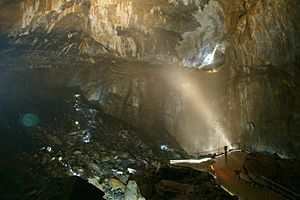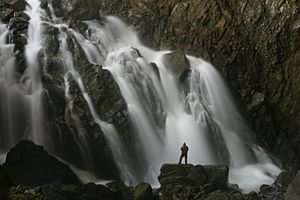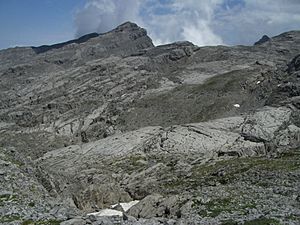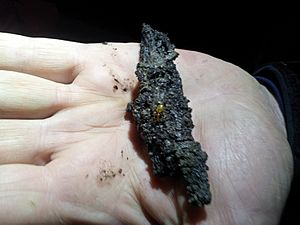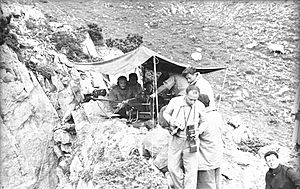La Verna cave facts for kids
La Verna is an amazing show cave in the Pyrénées-Atlantiques area of France. It's famous for having the largest underground chamber open to visitors in the world! To get there, you walk through a tunnel that's about 660 meters (2,165 feet) long.
The main chamber, called the Salle de la Verna, is incredibly big. It's about 250 meters (820 feet) wide and 194 meters (636 feet) tall. Imagine a space so large it could fit several football fields! A river even flows into the chamber from high up on one wall, creating a beautiful waterfall before disappearing into rocks below.
The chamber was named after a group of scouts from Lyon, called the La Verna Troop. They helped during a difficult time in 1952 when a brave explorer named Marcel Loubens had an accident.
In 2003, something really cool happened: a regular hot-air balloon, big enough for four people, was flown inside the Salle de la Verna! This shows just how massive the chamber truly is.
Contents
How La Verna Formed: The Geology Story
La Verna is part of a much larger cave system called the Gouffre de la Pierre-Saint-Martin. This whole system is huge, stretching for about 86 kilometers (53 miles) and going down 1,410 meters (4,626 feet)! It has fourteen known entrances, and explorers are still finding new parts. This area is known as a karst region, which means the ground is made of rock that water can easily dissolve, creating caves. So far, explorers have mapped 13 underground rivers and a total of 288 kilometers (179 miles) of passages and chambers here.
Most of this giant cave system formed as water dissolved limestone rock from the Cretaceous period (a long time ago!). The main underground river flows until it hits a harder rock called schist, which water can't dissolve easily.
The Salle de la Verna itself formed where the river flowed from this hard schist onto a different type of limestone from the Devonian period. Over many, many years (starting about 200,000 years ago!), the river carved out new paths through the softer limestone. This process of water dissolving rock and parts of the cave collapsing created the huge chamber we see today. You can even see the different layers of ancient rock clearly in the chamber walls.
The water that flows through La Verna comes from high up on limestone plateaus, about 2,000 meters (6,562 feet) high. It then travels underground for a long distance before emerging as springs much lower down in the valley of Saint-Engrâce.
Amazing Animals: Life in the Dark
Even in this dark, underground world, there's a special community of animals. These creatures are mostly small invertebrates, like insects. They have adapted to life without light, so they are often blind and have no color in their bodies.
Two common types of insects found in La Verna are the Aphaenops loubensi and Aphaenops ochsi beetles. To survive, these insects need the air to be very humid. Their reproduction is quite unique: after mating, the female lays only one egg. From this egg, a tiny larva hatches, but it doesn't need to eat before it quickly changes into an adult beetle.
A biologist named Michel Cabidoche studied these fascinating animals in the 1960s. Since La Verna opened to visitors in 2010, a team of scientists from the French National Museum of Natural History has been carefully watching how these animals are doing.
A Timeline of Discovery and Use
- 1950-1951: Explorers discovered and explored the Lépineux shaft, which was about 320 meters (1,050 feet) deep. At the time, it was the deepest shaft ever explored!
- August 13, 1952: A sad event occurred when Marcel Loubens, a brave explorer, died after a fall during an expedition. He passed away 36 hours later.
- August 13, 1953: Exactly one year later, a team of explorers including Georges Lépineux and Jimmy Théodor discovered the Salle de la Verna! They split into two groups: one to find the way, and the other to map it. They met inside the huge chamber and wrote their names. They had found what was then the world's largest known underground chamber, and they also set a new depth record.
- 1956-1960: The French National Electricity Company (EDF) started building a tunnel. Their idea was to capture the underground river in La Verna to make electricity. It took four years to dig the tunnel, but they eventually stopped the project due to technical problems. Cavers then started using this tunnel as a shortcut to explore more of the cave system.
- 2000: A private company called SHEM decided to restart the hydro-electric power project.
- January 2006: Work began again. They fixed up the old tunnel and built a new road. They also built a small dam where the river enters the Salle de la Verna, creating a small pool of water. Over 3 kilometers (1.8 miles) of pipes were installed across the chamber, out through the tunnel, and down to a power plant built in the valley below. Because the company worked closely with cavers and local authorities, it led to the idea of opening La Verna to the public.
- June 2007: Local authorities and caving groups worked together to manage the site. The cavers even created a small company to organize guided tours.
- July 1, 2010: La Verna officially opened to the public! Now, almost everyone can visit this amazing cave, including people with reduced mobility.
See also
 In Spanish: Sala de la Verna para niños
In Spanish: Sala de la Verna para niños


